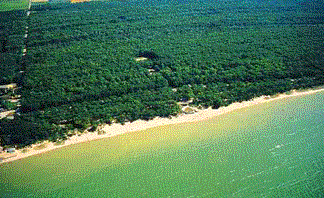A SHORT HISTORY OF THE DUNES
A dune is a rounded hill of drifted
sand. Most dunes are found in dry places like a desert and are
often barren mounds. Great Lakes sand dunes, however, are home
to many forms of life along the shores of an enormous lake. The
dunes support many microclimates of plants and animals not found
anywhere else in the world.
 Dunes are been on the Great Lakes
shorelines for thousands of years. The materials of the sand came
from hard bedrock which existed for millions of years. Some could
even be billions of years old.
A million years of ice ages accelerated
the erosion and transported it to the Great Lakes on sheets of
ice. When the glaciers began to melt over 10,000 years ago, they
washed enormouns amounts of debris through glacial lakes and down
rivers. The glaciers left tremendous amounts of water and raw
material that tltimately eroded further into the small grains
we call sand.
The very old sand served as the
main ingredient for the dunes. Quartz became the dominant sand
mineral along with small parts of feldspar, magnetite, garnet,
calcite, ilmenite, hornblende, and epidote. The Indiana dunes
have been here for 3,000 to 4,000 years.
Many seashores and Great Lakes
shorelines have the basic ingredients for dune formation (sand,
vegetation and geography) but lack one essential factor--a consistent
onshore wind. These onshore winds initiate lake currents and move
dry sand inland. Prevailing winds have concentrated dunes on the
south and east shore of Lake Michigan.
To become a dune of any size,
sand which has been blown by the wind must be caught and accumulate.
Sand will collect around objects such as driftwood and will easily
bury exposed objects, only to move on with the next gust of wind.
Without plant life such as the dune-building marram grass, dunes
will not grow in height and breadth.
Dunes are been on the Great Lakes
shorelines for thousands of years. The materials of the sand came
from hard bedrock which existed for millions of years. Some could
even be billions of years old.
A million years of ice ages accelerated
the erosion and transported it to the Great Lakes on sheets of
ice. When the glaciers began to melt over 10,000 years ago, they
washed enormouns amounts of debris through glacial lakes and down
rivers. The glaciers left tremendous amounts of water and raw
material that tltimately eroded further into the small grains
we call sand.
The very old sand served as the
main ingredient for the dunes. Quartz became the dominant sand
mineral along with small parts of feldspar, magnetite, garnet,
calcite, ilmenite, hornblende, and epidote. The Indiana dunes
have been here for 3,000 to 4,000 years.
Many seashores and Great Lakes
shorelines have the basic ingredients for dune formation (sand,
vegetation and geography) but lack one essential factor--a consistent
onshore wind. These onshore winds initiate lake currents and move
dry sand inland. Prevailing winds have concentrated dunes on the
south and east shore of Lake Michigan.
To become a dune of any size,
sand which has been blown by the wind must be caught and accumulate.
Sand will collect around objects such as driftwood and will easily
bury exposed objects, only to move on with the next gust of wind.
Without plant life such as the dune-building marram grass, dunes
will not grow in height and breadth.

